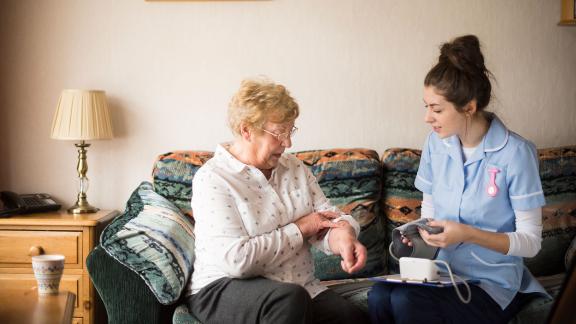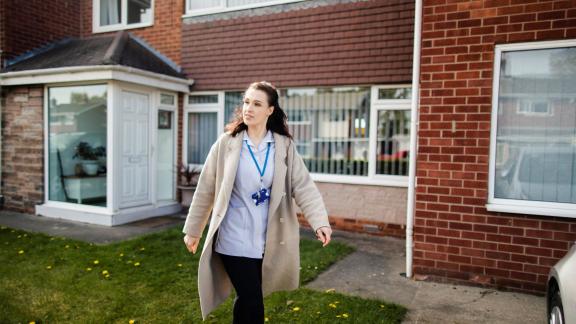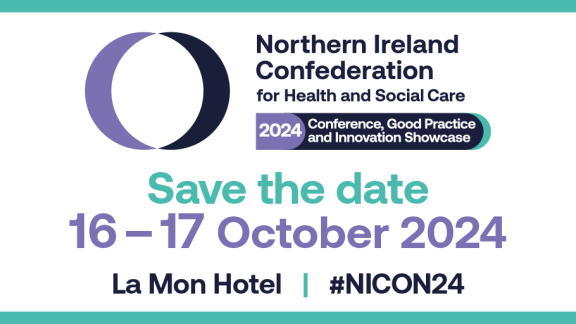Supporting people with frailty
Key points
Approximately 69 per cent of people over 85 live with multiple conditions, and 35 per cent of all people aged 65 and above live with some form of frailty.
Evidence suggests that approximately 47 per cent of hospital inpatients aged over 65 are affected by frailty, costing the UK healthcare system around £5.8 billion a year.
The health and care system must think differently about the way it supports this significant cohort of people, and their informal carers and families, to ensure they stay well for as long as possible at, or close to, home.
Supporting people with frailty at home is often beneficial for the individual, who is able to stay well and independent in familiar surroundings for longer. It can also reduce pressure on the wider health and care system and support patient flow.
Community staff, alongside wider system partners, are best placed to support people with frailty to stay well in their own home through preventative measures and crisis response initiatives, as well as diverting people from the front door of hospitals where appropriate and delivering intermediate care to help people recover after a hospital stay.
Community providers and their partners are already thinking innovatively about how they can support people with frailty to live well at home. But some people with frailty are still going without the support they need, with impacts for carers and families as well as pressure points in the health and care system.
Progressing the frailty agenda must receive local and national prioritisation and support to ensure services can be delivered consistently and at scale.

This briefing from the Community Network, hosted by the NHS Confederation and NHS Providers, explores the vital role that community providers can and do play in supporting people with frailty at every stage of the care pathway.
Introduction
Frailty related to the ageing process is defined as how our bodies ‘gradually lose their in-built reserves, leaving us vulnerable to sudden changes in health triggered by seemingly small events such as a minor infection or a change in medication or environment.’
This briefing highlights the benefits of supporting people with frailty in the community at every stage of the frailty care pathway, while considering the risks to be managed. It shares examples of good practice, and explores some of the barriers to further progress, looking at what can be done to address these and ensure people with frailty receive the right care at the right time in the right place.
The impacts of frailty and current policy
In England, there are currently 11 million people aged over 65, with the number expected to rise by 32 per cent (3.5 million) by 2043. The number of people over 85 is also predicted to double in the next 25 years, from 1.3 million to 2.6 million. Approximately 69 per cent of people over 85 live with multiple conditions, and 35 per cent of all older people (aged 65 and above) live with some form of frailty. Age-related illness such as dementia are also predicted to rise in prevalence. This means that a very large proportion of older people require some form of health and care support to live well, particularly in the last years and months of their life.
Evidence suggests that approximately 47 per cent of hospital inpatients aged over 65 are affected by frailty, costing the UK healthcare system around £5.8 billion a year. And almost half of all people arriving in A&E by ambulance in 2021/22 were over 65, with a third over 75. This is particularly concerning as recent data shows that many older people who are ready to be discharged from hospital face significant delays, with research suggesting that over a fifth are waiting for short-term rehabilitation in the community. In a significant number of local authority areas, over 65s make up a third or more of the population.
The increasing numbers of people with frailty will have a significant impact on health and care provision. The health and care system must therefore think differently about the way it supports this significant cohort of people, and their informal carers and families, to ensure they stay well for as long as possible at, or close to, home. Supporting people with frailty at home is often beneficial for the individual, who is able to stay well and independent in familiar surroundings for longer, as well as their family and friends who support them. It can also reduce pressure on the wider health and care system and support patient flow.
Recognising this, the past few years have seen a significant shift in national policy towards supporting people with frailty to live well at or closer to their home through community-led initiatives. In December 2023 NHS England published the proactive care framework, which supports a more ‘consistent approach to proactive care across the country for people living at home with moderate or severe frailty’. The guidance provides some examples of best practice as well as five core components of the proactive care approach including: case identification; holistic assessment; personalised care and support planning; coordinated and multi-disciplinary working; and continuity of care.
Community and primary care providers working together will be central to achieving national ambitions to support more people with frailty to live well at or closer to home. The sector plays a key role at every stage of the frailty care pathway in prevention, crisis response and intermediate care.
The case for supporting people with frailty in the community
People living with frailty can experience a number of complications with their health. They often need to manage multiple long-term conditions, are at risk of worsening health through falls, of developing conditions such as anxiety and depression, and they are more likely to have unplanned hospital admissions.
In light of this, identifying people with frailty has been a key priority for the NHS, forming part of the GP contract since 2017/18 and in 2024/25 through the use of the electronic frailty index. This tool aims to target a small number of interventions at those most at risk of hospitalisation, nursing home admission and death.
If an individual benefits from early interventions within the community before their health deteriorates, the risk of a hospital admission can be minimised. This is important because, although a stay in hospital is sometimes necessary, there are inherent risks associated with both admission and a prolonged stay. For example, people can be exposed to healthcare-acquired infections, and suffer with deconditioning and a general deterioration in their sense of independence and wellbeing. It is often the case that people living with frailty are particularly susceptible to these risks, and do not recover to previous levels of health or independence after long periods in hospital.
Supporting people with frailty to stay well at, or close to, home is also important in reducing pressure across the whole health and care system, particularly during periods of heightened pressure such as over winter. The winter resilience plan for 2023/24 highlighted the importance of bolstering frailty services to avoid unnecessary hospital admissions.
For people with frailty, access to both preventative and urgent care delivered in the community can reduce the need for ambulance callouts and hospital admissions, improving flow through the system.
Hospital admissions are essential in some cases, and providing the right support for people with frailty to return home after a stay in hospital is another important part of the puzzle. A well-resourced, enhanced approach to intermediate care can support people with frailty with rehabilitation and reablement support, promoting independence and reducing the risk of readmissions.
The role of community providers in supporting people with frailty
Prevention and early intervention
Community providers, in partnership with social care, primary care and colleagues in the voluntary, community and social enterprise (VCSE) sector, have a key role to play in delivering proactive care and preventing deterioration of people living with frailty, working with these people and their families. In many cases, community providers are working collaboratively to deliver enhanced health in care homes (EHCH), as part of the EHCH model of care. This is a proactive model that is centred on the needs of individual people, many of whom live with frailty, their families and care home staff.
Community provider leaders also recognise their role in secondary and tertiary prevention. Secondary prevention refers to ‘systematically detecting the early stages of disease and intervening before full symptoms develop’ with tertiary prevention being defined as ‘softening the impact of an ongoing illness of injury that has lasting effects. As such, interventions help people manage long-term, often complex health problems… in order to improve as much as possible their ability to function, their quality of life and their life expectancy’.
Given their ongoing relationships and interactions with patients, frontline staff working in community providers are well placed to support people to manage frailty in the community. They are able to identify concerns at an early stage, thus reducing the risk of deterioration and a hospital admission.
The team at Blackpool Teaching Hospitals NHS Foundation Trust has set up a Community Frailty Service to support patients who have at least one long-term health condition, including frailty, to live well alongside their existing conditions. The service is made up of a multidisciplinary team of health professionals who, upon referral, will visit a patient to work through their plan of care, which may include providing advice, education or equipment to support them to stay well at home.
Croydon Health Services NHS Trust has set up a Health Visitors for Older People (HVOP) team. The HVOP team visits people in their home and provides a supportive service to vulnerable, frail and isolated older people to help them retain their independence and prevent avoidable hospital admissions. The team is made up of health visitors, community nurses and health visitor support workers, all of whom work closely with families and carers to deliver a holistic assessment of a patient’s needs and provide a gateway to a variety of health and social services to promote independence. This may include falls and accident prevention, advice on benefit entitlement, health and nutrition support and bereavement support.
In order to support people living with frailty to stay independent in their own homes, Harrogate and District NHS Foundation Trust also has community care teams that integrate district nursing and therapy to deliver long- and short-term nursing interventions, rehabilitation, and support the management of long-term conditions. The teams provide an important role in keeping hospital admissions and readmissions to a minimum and ensure patients can stay independent in their own homes.
Virtual wards (also known as ‘hospital at home’) are another key way community providers, alongside wider partners across the health and care system, are supporting people with frailty who have hospital-level care needs to receive care at home and avoid an unnecessary hospital admission. Virtual wards can also be used to support people with frailty after a hospital stay. Just as in hospital, people on a virtual ward are cared for by a multidisciplinary team who can provide a range of tests and treatments including blood tests and prescribing medication. Patients are reviewed daily by the clinical team and the ‘ward round’ may involve a home visit or take place through video technology. Many virtual wards use technology like apps, wearables and other medical devices, enabling clinical staff to easily check in and monitor a person’s recovery. Trust leaders continue to work with patients and families, including older people and those with frailty, to ensure that the use of digital and technology is inclusive and based on informed consent and understanding.
As part of national guidance on virtual wards, all integrated care systems (ICSs) in England have been asked to expand virtual ward capacity, with a focus on the frailty pathway, reflecting the national ambition to deliver more care in the community. Community providers have worked hard with system partners to meet ambitious national targets to scale up capacity and usage, with 10,000 virtual wards beds created by autumn 2023, and more than 240,000 patients treated to date.
At Kent Community Health NHS Foundation Trust, clinicians within the community frailty team are supporting people with frailty in their own home through a frailty Hospital at Home virtual ward. As part of the virtual ward, care is delivered by a multi-disciplinary team who accept referrals from a range of system partners with the aim of providing an alternative to hospital care in a person’s home and in care homes. This is beneficial both for patients, who are able to receive hospital-level care in a familiar setting close to family and friends, and wider system flow, by preventing the risk of unnecessary hospital admissions.
“We were over the moon when we realised he could have treatment at home rather than going to hospital. The service the team provided was second to none and he was so much better when he was discharged.” Relative of patient in Kent.
Central London Community Healthcare NHS Trust’s Hospital at Home virtual ward services provide safe and convenient hospital-level care to people with frailty in the comfort of their own home. This supports individuals to reduce the length of their hospital stay or even avoid being admitted to hospital altogether. People on a Hospital at Home virtual ward are cared for by a multi-skilled team who can provide a range of tests and treatments, such as blood tests, with on-the-spot results. They can also prescribe medication and administer medications through an intravenous drip. Patients are reviewed daily by their clinical team, which may involve a home visit or take place through video technology that enables clinical staff to easily check in and monitor their recovery.
Crisis response
Although community providers are working hard to reduce the risk of people requiring urgent care through the delivery of preventative and early intervention services, there are times when urgent and emergency care is necessary. However, this care does not always have to be delivered by an ambulance or paramedic. Across the country, community providers have been scaling up the delivery of urgent community response (UCR) services, which deliver rapid response care to patients in the community within two hours of receiving a call.
UCR services contribute to more appropriate and timely care for patients, reduce pressures on urgent and emergency care pathways, and improve patient flow through the whole health and care system. For people with frailty, UCR services play a particularly vital role in delivering the right care at the right time in the right place. For instance, people with frailty are more susceptible to falls, which are often classified as lower category ambulance calls, and can mean longer waits for a response.
Research conducted by the South East Coast Ambulance Service NHS Foundation Trust shows that for every hour spent on the floor, the probability of a conveyance to hospital increases by 10 per cent. UCR services can therefore play a key role in delivering timely and appropriate urgent care at home for people with frailty, and reducing pressure on urgent and emergency care pathways. For people living with frailty who have engaged in advanced care planning conversations, which involves an individual agreeing how they would like to be cared for in the future, the use of UCR can be vital to ensuring they are able to receive the care that works for them. Particularly if they wish to remain in familiar surroundings close to loved ones.
Over the past few years, community providers have been accelerating the delivery of UCR services in line with national targets, with a growing number of examples of good practice demonstrating clear benefits for patients and system flow.
Over the last six months Birmingham Community Healthcare NHS Trust’s UCR service has seen an increase in the number of people accessing the service, with approximately 170 referrals each week, in an urban area serving about 1 million people. The trust has found that approximately half of the UCR referrals they receive come from ambulance trusts (CAT 3/4 calls) and in most cases relate to frail people with chronic conditions. To date, the trust has found that the majority of frail people treated by UCR teams are not admitted to hospital, supporting wider pressures and bringing value to patients.
Walsall Healthcare NHS Trust also has a well-developed UCR service which, from March 2024, will be available 24/7, going beyond the national targets around access. As well as accepting referrals from system partners such as GPs and ambulance trusts, Walsall Healthcare NHS Trust has found that district nurses and therapists are often attending someone’s home to deliver a planned visit, but shifting to delivering UCR services when an urgent incident occurs. For example, a nurse may attend for a planned visit but encounter someone who requires urgent support to correct diabetic hypoglycaemia. The trust is working capture these instances in a more consistent way to demonstrate the value and scale of the service.
Front-door frailty services
Despite the important work community providers are doing to help people with frailty stay well at home, some will continue to present at A&E. According to the British Geriatrics Society, identifying frailty at the hospital front door can help trigger an early comprehensive geriatric assessment and ensure people with frailty have access to the most appropriate services quickly and, where possible, be discharged on the same day.
Evidence suggests that people over 65 who are admitted to hospital are more likely to experience long stays and delayed discharges. As well as improving the experience and outcomes for those attending hospital, front-door frailty services support patient flow and alleviate pressure on the wider system.
Although front-door frailty services are not consistently available across the country, there are examples of where these services have been established with clear benefits for patients and system flow.
Wye Valley NHS Trust set up a frailty same-day emergency care unit in Hereford County Hospital in September 2023. The hospital already had a well-established front-door frailty team made up of advanced clinical practitioners, but the addition of a new bedded assessment area gave the team a physical base with a more appropriate environment to assess patients. The team also benefits from the presence of a geriatrician and frailty nurses who have expertise in the care of older people and can work with patients to support independence and prevent deconditioning.
The majority of patients treated at the unit are pulled from the emergency department, with a view to optimising workflow and capacity. Around two-thirds of patients are discharged and for anyone who needs to be admitted into hospital, the team ensures they are referred to the most appropriate acute medical ward. The team also has access to community rehabilitation hospitals for relevant patients.
In the first three weeks of opening, the team saw over 150 patients on the unit and outreached to around 50 more. from patients and their relatives who are so grateful of being cared for in a dedicated unit.
In December 2022, Tameside and Glossop Integrated Care NHS Foundation Trust set up a frailty same-day emergency care unit in Tameside Hospital, with the aim of providing comprehensive assessment and care for acutely unwell patients who are 65 and over. All patients are now screened each day for frailty, and those who need it are quickly transferred for a comprehensive assessment and treatment. Where appropriate, same-day community discharge is arranged to avoid an unnecessary hospital admission.
“From the minute this team took over the experience felt so different. The whole team were all extremely knowledgeable, friendly and caring. My mum got expert care and was involved all the way through the process. The reason why this experience was so important was that it meant her last days were spent with a team who really cared for her, and we could not have asked for more support, not just for her but for us too. The staff and doctors were outstanding in their attention to detail and high level of communication.
Very thorough ward and services, lovely caring and kind staff. Much needed holistic approach.” Relative of patient in Tameside and Glossop.
Intermediate care
Intermediate care is particularly important for people living with frailty. This type of support can help people with frailty access additional support on a time-limited basis to prevent an unnecessary hospital admission, as well as help people to regain their independence and support them to recover at home after a hospital stay, in turn reducing the risk of readmission to hospital and reducing pressures on hospital capacity.
To date, national policy has focused on how intermediate care can support people after a hospital stay, otherwise known as ‘step-down’ care.
According to NHS England’s intermediate care framework, published in September 2023, step-down intermediate care is ‘time-limited, short-term health and/or social care provided to adults who need support after discharge from acute inpatient settings and virtual wards to help them rehabilitate, re-able and recover.’ Care is often delivered by a multi-disciplinary team made up of health and social care staff working in integrated ways to deliver more holistic, wraparound care for the benefit of patients. Alongside key partners across the health and care system, community providers have a vital role to play in delivering these services.
Health and social care partners across Warwickshire have been working together to improve timely access to therapeutic intermediate care services upon discharge from hospital through the establishment of a community recovery service. The service began in April 2023 and allows more people to access rehabilitation and recovery services after a hospital stay, with the aim of reducing length of stay in acute hospitals and maximising the home-first approach. The package of intermediate care is provided and paid for by the NHS via the Better Care Fund for up to six weeks, with individuals being encouraged to maximise the use of this time to reduce the need for further care.
As part of this programme, all patients who are assessed as being ready to be discharged to a usual place of residence or temporary accommodation with some form of health and/or care and support needs (pathway 1), are triaged by the therapy team to decide if they need ongoing therapeutic intervention alongside a domiciliary care package. Care is delivered at a person's home by the community recovery service, which is made up of domiciliary care workers and allied health professionals from South Warwickshire University NHS Foundation Trust.
Walsall Healthcare NHS Trust has a well-established intermediate care service delivered by a multi-disciplinary team across Walsall Healthcare NHS Trust and Walsall adult social care. The service provides short-term, intensive support to patients to help them leave hospital as soon as it is safe to do so. The team, which is made up of a range of health and care professionals, offers support to help patients regain their independence, either at home or in a short-stay care home bed, in a way that best suits their needs.
Scaling up existing work to support people with frailty
As evidenced by the examples of good practice in this briefing, there is a lot of important work and innovation that can take place at a provider and system level to ensure people with frailty receive the right care at the right time. There is a role for organisations such as NHS Providers and NHS Confederation to ensure that good practice is shared effectively.
There is also a role for national policymakers to further support local work. According to a recent study, funding cuts to the NHS, public health and social care during the austerity years can be linked to a significant rise in the number of people living with frailty since 2010. Looking ahead, progressing the frailty agenda must be a key local and national priority.
To make the most of the opportunities outlined in this briefing, there are a number of actions that providers, integrated care systems and national policymakers must work together to achieve:
- Deliver greater investment in public health, prevention and community services to ensure that the sector is adequately resourced to intervene early, prevent deterioration, and where necessary, deliver accessible and modern support, particularly Hospital at Home/virtual ward, during a crisis and after a hospital stay.
- Lift the barriers to further integration between community providers, primary care and social care, particularly around capital investment, digital capacity, data sharing, and reform and investment in social care.
- Implement the NHS Long Term Workforce Plan, which commits to growing the community workforce to ensure there are the right number and mix of staff to deliver more care in the community.
- Tackle workforce shortages in social care to ensure that there are sufficient staff in the sector to support people to live flourishing lives in the community, therefore supporting the prevention agenda.
- Engage with clinicians to ensure that frontline staff are confident in leading and championing new ways of working and managing risk for these groups of patients.
- Engage with people suffering with frailty, as well as their families and carers, to deliver care in a way that best suits their needs and care arrangements.
- Enable those working in the health and care sector to work more effectively with people suffering with frailty, as well as their families and carers, to design and deliver care in a way that best suits their needs and care arrangements.
Conclusion
This briefing highlights the vital role community providers play in supporting people with frailty at every stage of the care pathway. Community staff, alongside wider system partners, support people with frailty to stay well in their own home through preventative measures and crisis response initiatives, as well as diverting people from the front door of hospitals where appropriate and delivering intermediate care to help people recover after a hospital stay.
Each of these interventions provide an opportunity to deliver care for individuals closer to home, where they often prefer to be treated, which is invaluable both for individuals and can support the flow of patients through the health and care system.
Despite the important work that community providers are undertaking, it is clear that some people with frailty are still going without the support they need to enable them to stay well at home, with impacts for carers and families as well as pressure points in the health and care system. Insufficient staff and investment within the community and social care sectors means providers are unable to scale up and maximise many of the community-led initiatives outlined in this briefing. Cuts to preventative services and public health funding have also contributed to people presenting with more complex and acute care needs which require more specialised care.
As this briefing shows, community providers, and their partners, are already thinking innovatively about how they can support people with frailty to live well at home, but to achieve this in a meaningful way, they need national prioritisation and support to ensure services can be delivered consistently and at scale. This is essential as demographic changes mean demand for services will continue to rise, and the health and care system will need to effectively and sustainably prevent and treat more people in the community.




